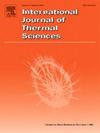喷雾气溶胶双皮肤辐射传输模型的研究
IF 4.9
2区 工程技术
Q1 ENGINEERING, MECHANICAL
International Journal of Thermal Sciences
Pub Date : 2025-03-18
DOI:10.1016/j.ijthermalsci.2025.109875
引用次数: 0
摘要
向双层幕墙的空腔中喷洒雾滴可以改善其热工性能。然而,喷雾系统开启后,分散在空腔中的雾滴(气溶胶)会改变太阳辐射通过双层幕墙的传输机制。本研究基于米氏散射理论和净辐射法,建立了带有喷雾气溶胶的双层幕墙太阳辐射传输模型。该模型计算了带有喷雾气溶胶的双层幕墙的透射率、反射率和吸收率。实验验证结果表明,模型与实验结果一致,太阳辐射热获得的最大误差约为 11.2%。此外,本研究还探讨了影响喷洒气溶胶双层幕墙光学特性的关键因素,包括气溶胶粒子数浓度、平均半径、空腔距离和入射角。结果表明,总透射率随着气溶胶浓度和平均半径的增加而降低。然而,当气溶胶浓度超过 600 粒子/立方厘米、平均半径超过 15 微米时,透射率的降低就不那么明显了。在气溶胶浓度较高时,腔距和入射角的变化对透射率的影响很小。通过控制气溶胶浓度和平均半径,可以有效减少太阳辐射热获得。该模型准确描述了真实条件下的太阳辐射传输,有助于评估喷洒气溶胶的双层幕墙的光学和热学特性。本文章由计算机程序翻译,如有差异,请以英文原文为准。
Study on solar radiation transfer model of double skin façade with spray aerosol
Spraying droplets into the cavity of the double skin façade can improve its thermal performance. However, the spray system is opened, the mist droplets (aerosols) dispersed in the cavity alter the transmission mechanism of solar radiation through the double skin façade. This study develops a solar radiation transfer model for double skin facade with spray aerosol based on the Mie scattering theory and the net radiation method. The model calculates the transmittance, reflectance, and absorptance of the double skin façade with spray aerosol. Experimental validation shows good agreement with the model, with a maximum error of approximately 11.2 % for solar heat gain. Additionally, this study examines key factors that influence the optical properties of the double skin facade with spray aerosol, including aerosol particle number concentration, average radius, cavity distance, and incidence angle. The results indicate that total transmittance decreases as aerosol concentration and average radius increase. However, when the concentration exceeds 600 particles/cm3 and the average radius exceeds 15 μm, the reduction in transmittance becomes less pronounced. Changes in cavity distance and incidence angle have a minimal effect on transmittance at high aerosol concentrations. By controlling aerosol concentration and average radius, solar heat gain can be effectively reduced. The model accurately describes solar radiation transmission in real conditions, helping assess the optical and thermal properties of double skin façades with spray aerosol.
求助全文
通过发布文献求助,成功后即可免费获取论文全文。
去求助
来源期刊

International Journal of Thermal Sciences
工程技术-工程:机械
CiteScore
8.10
自引率
11.10%
发文量
531
审稿时长
55 days
期刊介绍:
The International Journal of Thermal Sciences is a journal devoted to the publication of fundamental studies on the physics of transfer processes in general, with an emphasis on thermal aspects and also applied research on various processes, energy systems and the environment. Articles are published in English and French, and are subject to peer review.
The fundamental subjects considered within the scope of the journal are:
* Heat and relevant mass transfer at all scales (nano, micro and macro) and in all types of material (heterogeneous, composites, biological,...) and fluid flow
* Forced, natural or mixed convection in reactive or non-reactive media
* Single or multi–phase fluid flow with or without phase change
* Near–and far–field radiative heat transfer
* Combined modes of heat transfer in complex systems (for example, plasmas, biological, geological,...)
* Multiscale modelling
The applied research topics include:
* Heat exchangers, heat pipes, cooling processes
* Transport phenomena taking place in industrial processes (chemical, food and agricultural, metallurgical, space and aeronautical, automobile industries)
* Nano–and micro–technology for energy, space, biosystems and devices
* Heat transport analysis in advanced systems
* Impact of energy–related processes on environment, and emerging energy systems
The study of thermophysical properties of materials and fluids, thermal measurement techniques, inverse methods, and the developments of experimental methods are within the scope of the International Journal of Thermal Sciences which also covers the modelling, and numerical methods applied to thermal transfer.
 求助内容:
求助内容: 应助结果提醒方式:
应助结果提醒方式:


